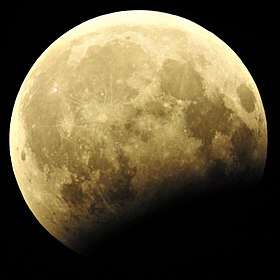April 2005 lunar eclipse
A penumbral lunar eclipse took place on April 24, 2005, the first of two lunar eclipses in 2005. At maximum eclipse, 87% of the Moon's disc was partially shaded by the Earth, which caused a slight shadow gradient across its disc; this subtle effect may have been visible to careful observers. No part of the Moon was in complete shadow. The eclipse lasted 4 hours and 6 minutes overall, and was visible from east Asia, Australia, and the Americas.
| Penumbral Lunar Eclipse April 24, 2005 | |
|---|---|
 The eclipse over Minneapolis, Minnesota, with inset images of the rising full moon a few hours before the eclipse, and the setting moon at 9:55 UTC near greatest eclipse. | |
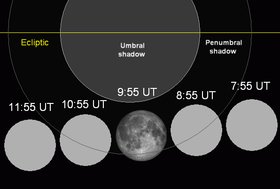 The moon passed right to left through the Earth's southern penumbral shadow. | |
| Series (and member) | 141 (23) |
| Date | 24 April 2005 |
| Duration (hr:mn:sc) | |
| Penumbral | 4:05:38 |
| Contacts | |
| P1 | 7:52:06 UTC |
| Greatest | 9:54:51 UTC |
| P4 | 11:57:44 UTC |
 The moon's path across southern penumbral shadow in Virgo. | |
The tables below contain detailed predictions and additional information on the Penumbral Lunar Eclipse of 24 April 2005.
Eclipse Characteristics
Penumbral Magnitude: 0.86507
Umbral Magnitude: -0.14351
Gamma: -1.08851
Saros Series: 141st (23 of 72)
Opposition Times
Greatest Eclipse: 24 Apr 2005 09:54:49.7 UTC (09:55:54.4 TD)
Ecliptic Opposition: 24 Apr 2005 10:06:28.6 UTC (10:07:33.3 TD)
Equatorial Opposition: 24 Apr 2005 10:51:14.6 UTC (10:52:19.3 TD)
Geocentric Coordinates of Sun and Moon
Sun right ascension: 2.14
Sun declination: 13
Sun diameter: 1908.2 arcseconds
Moon right ascension: 14.11
Moon declination: -13.9
Moon diameter: 1892.0 arcseconds
Earth’s shadow right ascension: 14.14
Earth’s shadow declination: -13
Geocentric Libration of Moon
Latitude: 5.2 degrees south
Longitude: 1.4 degrees east
Direction: 18.3 (NNE)
Visibility

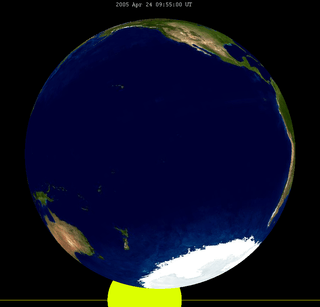

Member
This is the 23rd member of Lunar Saros 141. The previous event was the April 1987 lunar eclipse. The next event is the May 2023 lunar eclipse.
Related eclipses
Eclipses of 2005
Lunar eclipse 2002-2005
It is the last of four lunar year cycles, repeating every 354 days.
| Lunar eclipse series sets from 2002–2005 | ||||||||
|---|---|---|---|---|---|---|---|---|
| Descending node | Ascending node | |||||||
| Saros Photo |
Date View |
Type Chart |
Gamma | Saros Photo |
Date View |
Type Chart |
Gamma | |
| 111 | 2002 May 26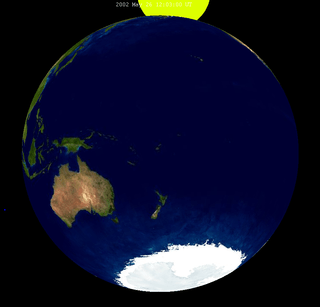 |
penumbral |
1.1759 | 116 | 2002 Nov 20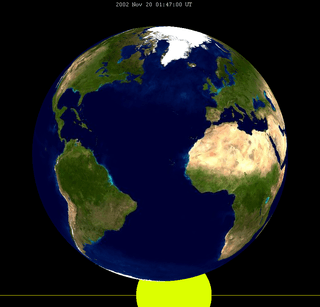 |
penumbral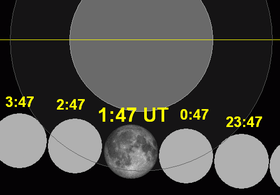 |
-1.1127 | |
121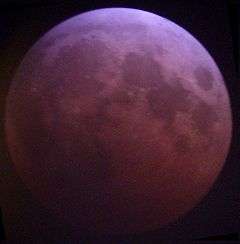 |
2003 May 16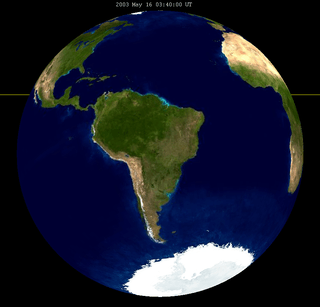 |
total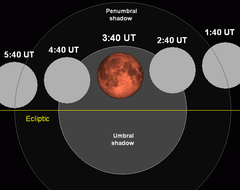 |
0.4123 | 126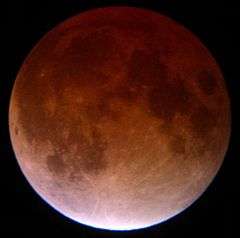 |
2003 Nov 09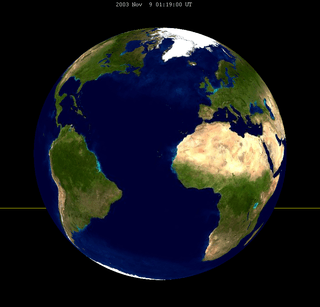 |
total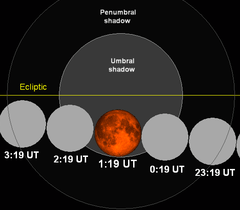 |
-0.4319 | |
131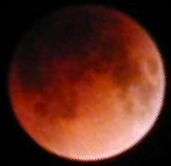 |
2004 May 04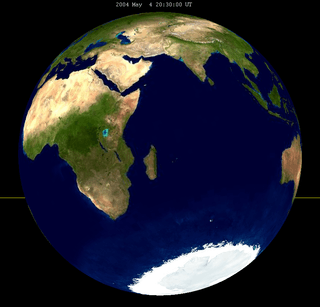 |
total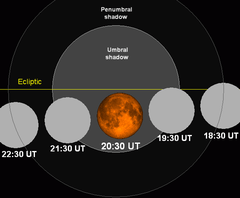 |
-0.3132 | 136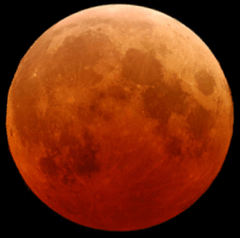 |
2004 Oct 28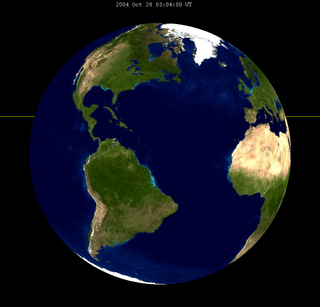 |
total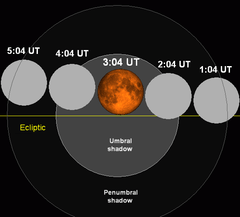 |
0.2846 | |
| 141 | 2005 Apr 24 |
penumbral |
-1.0885 | 146_(cropped).jpg) |
2005 Oct 17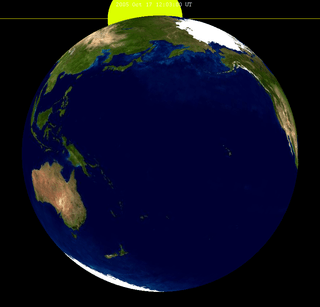 |
partial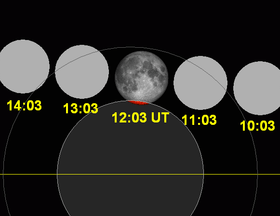 |
0.9796 | |
| Last set | 2002 Jun 24 | Last set | 2001 Dec 30 | |||||
| Next set | 2006 Mar 14 | Next set | 2006 Sep 7 | |||||
Saros series
Lunar Saros 141, repeating every 18 years and 11 days, has a total of 72 lunar eclipse events including 26 total lunar eclipses.
First Penumbral Lunar Eclipse: 1608 Aug 25
First Partial Lunar Eclipse: 2041 May 16
First Total Lunar Eclipse: 2167 Aug 01
First Central Lunar Eclipse: 2221 Sep 02
Greatest Eclipse of the Lunar Saros 141: 2293 Oct 16
Last Central Lunar Eclipse: 2546 Mar 18
Last Total Lunar Eclipse: 2618 May 01
Last Partial Lunar Eclipse: 2744 Jul 16
Last Penumbral Lunar Eclipse: 2888 Oct 11
1901-2100
March 1915 lunar eclipse
May 2059 lunar eclipse
June 2077 lunar eclipse
June 2095 lunar eclipse
Metonic series
This eclipse is the last of four Metonic cycle lunar eclipses on the same date, April 23–24, each separated by 19 years:
The Metonic cycle repeats nearly exactly every 19 years and represents a Saros cycle plus one lunar year. Because it occurs on the same calendar date, the Earth's shadow will in nearly the same location relative to the background stars.
| Descending node | Ascending node | |||||
|---|---|---|---|---|---|---|
| Saros | Date | Type | Saros | Date | Type | |
| 111 | 1948 Apr 23.56 | Partial | 116 | 1948 Oct 18.10 | Penumbral | |
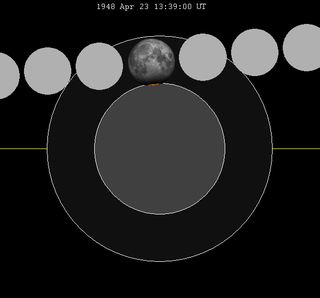 |
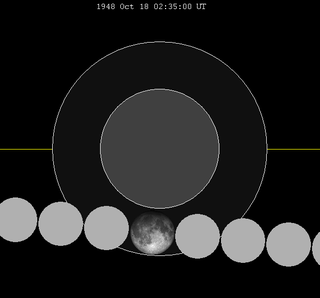 | |||||
| 121 | 1967 Apr 24.50 | Total | 126 | 1967 Oct 18.42 | Total | |
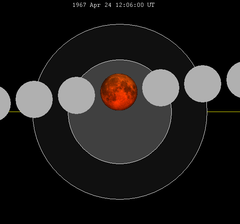 |
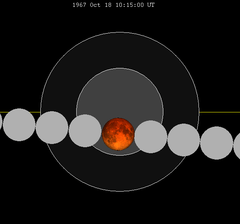 | |||||
| 131 | 1986 Apr 24.52 | Total | 136 | 1986 Oct 17.80 | Total | |
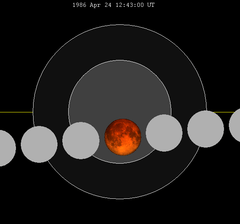 |
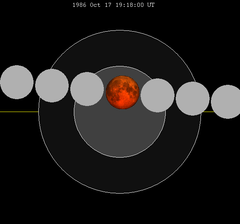 | |||||
| 141 | 2005 Apr 24.41 | Penumbral | 146 | 2005 Oct 17.50 | Partial | |
 |
 | |||||
Half-Saros cycle
A lunar eclipse will be preceded and followed by solar eclipses by 9 years and 5.5 days (a half saros).[1] This lunar eclipse is related to two solar eclipses of Solar Saros 148.
| April 17, 1996 | April 29, 2014 |
|---|---|
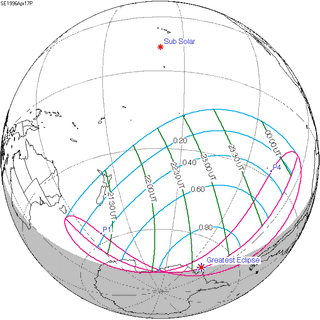 |
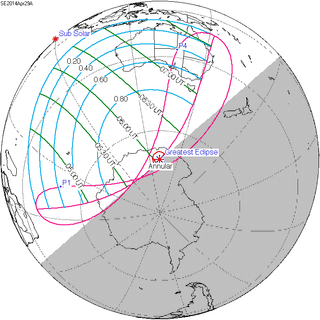 |
See also
- List of lunar eclipses and List of 21st-century lunar eclipses
- May 2003 lunar eclipse
- November 2003 lunar eclipse
- May 2004 lunar eclipse
- File:2005-04-24 Lunar Eclipse Sketch.gif Chart
References
- Mathematical Astronomy Morsels, Jean Meeus, p.110, Chapter 18, The half-saros
External links
- Saros cycle 141
- 2005 Apr 24 chart: Eclipse Predictions by Fred Espenak, NASA/GSFC
- Photo
